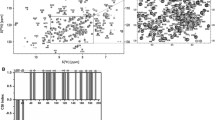Abstract
The mitochondrial antiviral signalling protein (MAVS) is a central signal transduction hub in the innate immune response against viral infections. Viral RNA present in the cytoplasm is detected by retinoic acid inducible gene I like receptors, which then activate MAVS via heterotypic interactions between their respective caspase activation and recruitment domains (CARD). This leads to the formation of active, high molecular weight MAVS complexes formed by homotypic interactions between the single N-terminal CARDs of MAVS. Filaments formed by the N-terminal MAVSCARD alone are sufficient to induce the autocatalytic conversion from a monomeric to an aggregated state in a prion-like manner. Here, we present the nearly complete spectroscopic 13C and 15N resonance assignments of human MAVSCARD filaments obtained from a single sample by magic angle spinning solid-state NMR spectroscopy. The corresponding secondary chemical shifts suggest that the filamentous form of MAVSCARD retains an exclusively alpha-helical fold that is very similar to the X-ray structure determined previously from monomeric MAVSCARD-maltose binding protein fusion constructs.



Similar content being viewed by others
References
Baldus M, Petkova AT, Herzfeld J, Griffin RG (1998) Cross polarization in the tilted frame: assignment and spectral simplification in heteronuclear spin systems. Mol Phys 95:1197–1207
Fogh R et al (2002) The CCPN project: an interim report on a data model for the NMR community. Nat Struct Biol 9:416–418
Fung BM, Khitrin AK, Ermolaev K (2000) An improved broadband decoupling sequence for liquid crystals and solids. J Magn Reson 142:97–101
Gardiennet C, Schutz AK, Hunkeler A, Kunert B, Terradot L, Bockmann A, Meier BH (2012) A sedimented sample of a 59 kDa dodecameric helicase yields high-resolution solid-state NMR spectra. Angew Chem 51:7855–7858
Habenstein B et al (2012) A native-like conformation for the C-terminal domain of the prion Ure2p within its fibrillar form. Angew Chem 51:7963–7966
Hellert J et al (2013) A structural basis for BRD2/4-mediated host chromatin interaction and oligomer assembly of Kaposi sarcoma-associated herpesvirus and murine gammaherpesvirus LANA proteins. PLoS Pathog 9:e1003640
Hou F, Sun L, Zheng H, Skaug B, Jiang QX, Chen ZJ (2011) MAVS forms functional prion-like aggregates to activate and propagate antiviral innate immune response. Cell 146:448–461
Kawai T, Akira S (2009) The roles of TLRs, RLRs and NLRs in pathogen recognition. Int Immunol 21:317–337
Kawai T et al (2005) IPS-1, an adaptor triggering RIG-I- and Mda5-mediated type I interferon induction. Nat Immunol 6:981–988
Liu XY, Chen W, Wei B, Shan YF, Wang C (2011) IFN-induced TPR protein IFIT3 potentiates antiviral signaling by bridging MAVS and TBK1. J Immunol 187:2559–2568
Loquet A et al (2012) Atomic model of the type III secretion system needle. Nature 486:276–279
Meylan E, Curran J, Hofmann K, Moradpour D, Binder M, Bartenschlager R, Tschopp J (2005) Cardif is an adaptor protein in the RIG-I antiviral pathway and is targeted by hepatitis C virus. Nature 437:1167–1172
Michallet MC et al (2008) TRADD protein is an essential component of the RIG-like helicase antiviral pathway. Immunity 28:651–661
Ritter C et al (2005) Correlation of structural elements and infectivity of the HET-s prion. Nature 435:844–848
Seth RB, Sun L, Ea CK, Chen ZJ (2005) Identification and characterization of MAVS, a mitochondrial antiviral signaling protein that activates NF-κB and IRF 3. Cell 122:669–682
Seth RB, Sun L, Chen ZJ (2006) Antiviral innate immunity pathways. Cell Res 16:141–147
Shahid SA, Bardiaux B, Franks WT, Krabben L, Habeck M, van Rossum BJ, Linke D (2012) Membrane-protein structure determination by solid-state NMR spectroscopy of microcrystals. Nat Methods 9:1212–1217
Shen Y, Delaglio F, Cornilescu G, Bax A (2009) TALOS+: a hybrid method for predicting protein backbone torsion angles from NMR chemical shifts. J Biomol NMR 44:213–223
Shi L, Ladizhansky V (2012) Magic angle spinning solid-state NMR experiments for structural characterization of proteins. Methods Mol Biol 895:153–165
Stevens TJ et al (2011) A software framework for analysing solid-state MAS NMR data. J Biomol NMR 51:437–447
Takegoshi K, Nakamura S, Terao T (2001) C13–H1 dipolar-assisted rotational resonance in magic-angle spinning NMR. Chem Phys Lett 344:631–637
Tang ED, Wang CY (2009) MAVS self-association mediates antiviral innate immune signaling. J Virol 83:3420–3428
Van Melckebeke H, Wasmer C, Lange A, Ab E, Loquet A, Bockmann A, Meier BH (2010) Atomic-resolution three-dimensional structure of HET-s(218-289) amyloid fibrils by solid-state NMR spectroscopy. J Am Chem Soc 132:13765–13775
Vranken WF et al (2005) The CCPN data model for NMR spectroscopy: development of a software pipeline. Proteins 59:687–696
Wishart DS, Sykes BD (1994) The 13C chemical-shift index: a simple method for the identification of protein secondary structure using 13C chemical-shift data. J Biomol NMR 4:171–180
Xu LG, Wang YY, Han KJ, Li LY, Zhai Z, Shu HB (2005) VISA is an adapter protein required for virus-triggered IFN-beta signaling. Mol Cell 19:727–740
Acknowledgments
We are grateful to Dr. Mumdooh Ahmed for recording the ssNMR spectra and for helpful discussions. L. H. has been supported by a fellowship from the HZI graduate school.
Author information
Authors and Affiliations
Corresponding author
Electronic supplementary material
Below is the link to the electronic supplementary material.
Rights and permissions
About this article
Cite this article
He, L., Lührs, T. & Ritter, C. Solid-state NMR resonance assignments of the filament-forming CARD domain of the innate immunity signaling protein MAVS. Biomol NMR Assign 9, 223–227 (2015). https://doi.org/10.1007/s12104-014-9579-6
Received:
Accepted:
Published:
Issue Date:
DOI: https://doi.org/10.1007/s12104-014-9579-6




